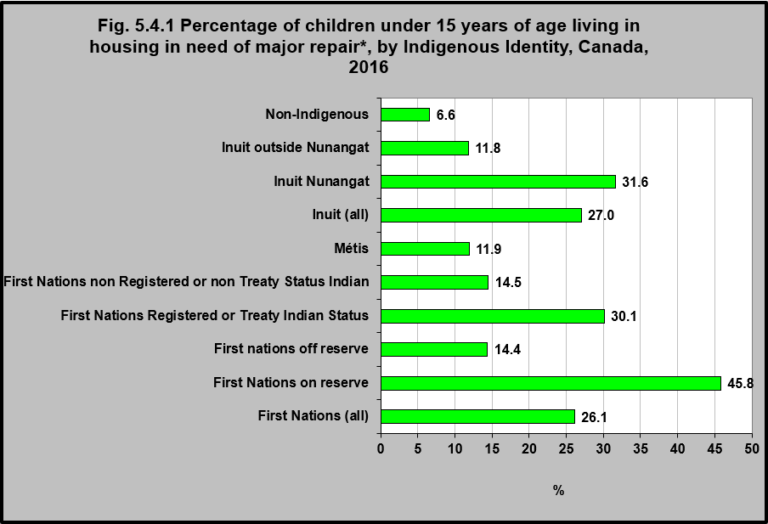Percentage of children under 15 years of age living in housing in need of major repair, by Indigenous Identity, Canada, 2016

Notes:
*Major repairs needed includes dwellings needing major repairs such as dwellings with defective plumbing or electrical wiring and dwellings needing structural repairs to walls, floors or ceilings.
Excludes census data for one or more incompletely enumerated Indian reserves or Indian settlements.
Users should be aware that the estimates associated with this variable are more affected than most by the incomplete enumeration of certain Indian reserves and Indian settlements in the Census of Population. For more information on Indigenous variables, including information on their classifications, the questions from which they are derived, data quality and their comparability with other sources of data, please refer to the Aboriginal Peoples Reference Guide, Census of Population, 2016 and the Aboriginal Peoples Technical Report, Census of Population, 2016.
Residence on or off reserve refers to whether the person’s usual place of residence is in a census subdivision (CSD) that is defined as ‘on reserve’ or ‘off reserve.’
Indigenous identity’ includes persons who are First Nations (North American Indian), Métis or Inuk (Inuit) and/or those who are Registered or Treaty Indians (that is, registered under the Indian Act of Canada) and/or those who have membership in a First Nation or Indian band. Indigenous peoples of Canada are defined in the Constitution Act, 1982, section 35 (2) as including the Indian, Inuit and Métis peoples of Canada.
Source: Statistics Canada – 2016 Census. Catalogue Number 98-400-X2016164.
http://www12.statcan.gc.ca/census-recensement/2016/dp-pd/dt-td/Rp-eng.cfm?TABID=2&LANG=E&A=R&APATH=3&DETAIL=0&DIM=0&FL=A&FREE=0&GC=01&GL=-1&GID=1341679&GK=1&GRP=1&O=D&PID=110519&PRID=10&PTYPE=109445&S=0&SHOWALL=0&SUB=0&Temporal=2017&THEME=122&VID=0&VNAMEE=&VNAMEF=&D1=0&D2=0&D3=1&D4=0&D5=0&D6=0 -accessed December 23, 2017.
In 2016, 26.1% of First Nations children under 15 lived in housing in need of major repair. That was the case for 11.9% of Métis children under 15 and 27.0% of Inuit children under 15.
First Nations children living on reserve were more likely to live in housing in need of major repair (45.8%) than were First Nations children living off reserve (14.4%)
First Nations children with Registered or Treaty Indian Status were more likely to live in housing in need of major repair (30.1%) than were those without status (14.5%).
Inuit children living in Inuit Nunangat were more likely to live in housing in need of major repair (31.6%) than were those living outside Nunangat (11.8%).
Non-Indigenous children under age 15 were the least likely to live in housing in need of major repair (6.6%).
Implications
The quality of housing, including access to clean running water, waste water disposal, ventilation, heating, electricity and the safety of the housing structure, is a major determinant of health.1 Indigenous people, especially First Nations on reserve and Inuit, are more likely than the general Canadian population to be living in a home that needs major repair.2 This has been linked to poorer health outcomes in Indigenous communities, especially among Indigenous children. Research has shown that poor quality housing has contributed to higher rates of respiratory infections, skin disease, parasites and nutritional disease in Indigenous children,3 as well as injuries.4
1National Collaborating Centre for Aboriginal Health. (2016). Housing as a determinant of First Nations, Inuit and Métis health. Prince George, BC: Author.
2Statistics Canada. (2015). Aboriginal Statistics at a Glance, 2nd Edition. Ottawa, ON: Author. Retrieved September 22, 2017 from http://www.statcan.gc.ca/pub/89-645-x/89-645-x2015001-eng.pdf
3OHTN Rapid Response Service. (2011). Review: Impact of housing status and supportive housing on the health of Aboriginal people. Toronto, ON: Ontario HIV Treatment Network.
4George, M.A., Brussoni, M., Jin, A., Lalonde, C.E., & McCormick, R. (2016). Ecological analyses of the associations between injury risk and socioeconomic status, geography and Aboriginal ethnicity in British Columbia, Canada. Springer Open, 5, 567, DOI: 10.1186/s40064-016-2262-x; Kohen, D.E., Bougie, E., & Guèvremont, A. (2015). Housing and health among Inuit children. Health Reports, 26(11), 21-27.
